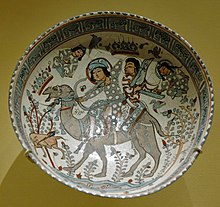



Persian pottery or Iranian pottery is the pottery made by the artists of Persia (Iran) and its history goes back to early Neolithic Age (7th millennium BCE).[1] Agriculture gave rise to the baking of clay, and the making of utensils by the people of Iran.[2] Through the centuries, Persian potters have responded to the demands and changes brought by political turmoil by adopting and refining newly introduced forms and blending them into their own culture. This innovative attitude has survived through time and influenced many other cultures around the world.
There were two types of earthenware that were prevalent in Iran around 4,000 BC: red and black ceramics that were simplistic in their decorative style.[2] As the art expanded, earthenware incorporated geometric designs which resulted in a more developed decorative style. This increasingly complex style was accompanied by the creation of a wider variety of the kinds of pottery that were made.
In the prehistoric period, the production of vessels included the mixture of clay, small pieces of various plants and straws, and water. When these ingredients were mixed together, they formed a very hard paste which essentially became the paste used for the base for creating all vessels in Iran. The creation of Vessels differed in the shape because they were made by hand. Around the 4th millennium BCE, the quality of vessel production enhanced because the potter's wheel was introduced.[2] This table was used to produce symmetrically shaped, and better quality vessels.
The Islamic prohibition on using vessels made of precious metal at the table meant that a new market for luxury ceramics opened up. This allowed the pre-Islamic elites of the earlier Persian empires to produce fancy glazes such as lustreware and high-quality painted decoration. Overall, Persian pottery expanded in their use of tools and styles to improve art production.
- ^ "The History of Persian Ceramics". California Academy of Sciences. 2010-02-02. Retrieved 2014-07-09.
- ^ a b c "Art of Pottery in Iran". www.iranreview.org. Retrieved 2019-11-05.